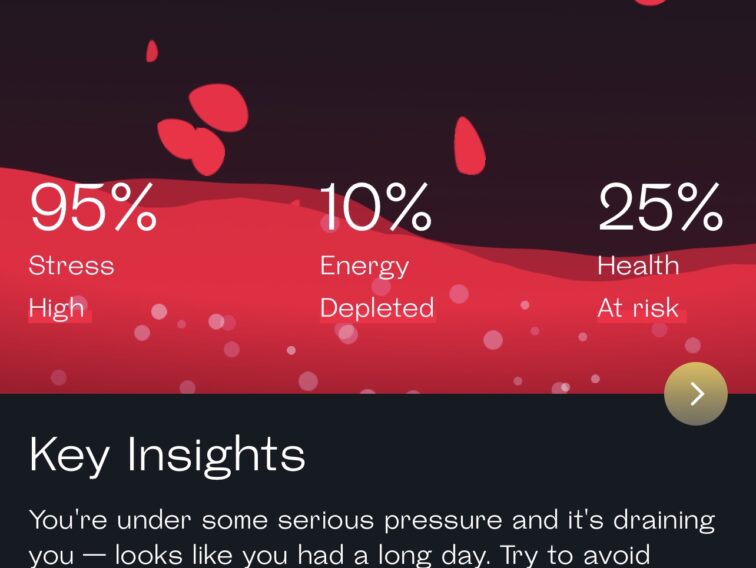My biggest lessons from running hundreds of gut tests on clients is that symptoms don’t tell you the full story.
Clients convinced they have yeast find a parasite instead. Those who suspect SIBO (small intestinal bacterial overgrowth) actually have h. pylori . This is because many gut pathogens can share similar symptoms.
It’s easy to Google your symptoms and get thrown off track. And by the time you get around to testing, you’re already exhausted, disillusioned and frustrated.
I’m a big fan of gathering data before you act (try a new diet or supplements) and using real-time data to track and support your healing progress.
Grounding yourself in real-time data, can lower anxiety as the fear of the unknown is replaced with the ability to gauge actual progress with solid info.
How you feel is not always a good indicator of what’s going on inside the body. Sometimes you feel worse because the healing protocol is working perfectly. Feeling worse, as the biome reorganizes, can confuse people and make them abandon the right path. Suffering as you heal can be avoided by adding rest days by stopping supplements or lowering/adjusting the dosage.
I have many success stories of clients who used testing and data to get better. But I’m sharing my personal story of how I used these tools to identify and address a gut problem before it got much worse. This is preventative medicine at its best.
My story
I traveled to Mexico in May and got a bad case of traveler’s diarrhea, which is not uncommon when traveling to developing countries like Mexico.
After I recovered from 5 days of intense diarrhea, I was left with bloating, really bad jet lag and gas. My energy was low and my bowel movements slowed down. All unusual for me.
After a few weeks the symptoms passed. The only thing that remained was inflammation in the form of sudden weight gain. Mostly, I felt ok because the gut symptoms were gone.
Eventually I took a stool test called the GI Map and it revealed an inflammatory bacteria called the blasto cystis hominis. This was what gave me diarrhea and threw off the rest of my biome. It suppressed by gut’s immune system (Sig A), and lowered my enzyme production and ability to digest fats. Parasites can cause havoc on the biome.
The reason I didn’t have long-term digestive symptoms was because my beneficial bacteria are pretty solid. And the good guys held onto their territory, preventing things from getting much worse. That is why I always focus on strategies to grow beneficial bacteria.
Why do a protocol when there are no symptoms?
Why fix something that doesn’t cause symptoms?
Because when major stress hits and my self care slips, the problem may flare and symptoms could appear. Symptoms tend to show us when the body/ immune system feels overwhelmed and can no longer balance the biome.
That is how people go from feeling fine one day to having symptoms the next. The problem did not appear overnight. It was there all along but a stressful trigger finally compromised the body’s ability to balance and cope.
And why did I take the GI Map without having clear symptoms?
Something tipped me off that something was out of whack. That my body had not recover fully from the episode of traveler’s diarrhea.
My blood sugar levels and nervous system health indicated that my body was stressed even though it wasn’t enough stress to produce symptoms.
I will do a parasite protocol, but before I share more details about that below, I’m sharing the tools that gave showed me there was a problem.
How to track body metrics
Monitoring your blood sugar
Stable blood sugar was an important part of my healing from IBS the first time (almost 20 years ago). I ate a diet that stabilized my blood sugar by avoiding sugar and grains.
These days I track my blood sugar with a continuous glucose monitor that I wear on my arm. It tells me how my meals affect my blood sugar. Since I have been wearing one for a while, I noticed that my blood sugar had gotten unstable from eating the same type of foods.
When your biome is disordered (I have a lot more pathogenic bacteria than before) it can affect your blood sugar response. The biome plays a big role in blood sugar regulation.
Continuous glucose monitors can be a bit expensive, but there’s a much cheaper method where you prick your finger to measure the glucose in your blood. You can buy this kit in any drug store. But many people are squeamish about pricking their finger.
Other things that can cause blood sugar swings are food sensitivities, so big swings after eating foods that are not high in carbs can be a clue about a food sensitivity.
Diabetics use continuous glucose monitors (CGMs) and you need a prescription from a doctor. But companies have started selling CGMs to consumers. Supersapiens and Zoe in Europe and Nutrisense and Levels in the U.S.
Using a glucose monitor taught me that it’s better to eat carbs earlier in the day because they are better metabolized and don’t affect blood sugar as much.
Tracking your heart rate variability.
I use an app on my phone called Welltory to track my heart rate variability (HRV). HRV tells you how stressed your body is or how fast you recover from stressors (exercise, travel, lack of sleep)
This app is free and it gives valuable feedback on level of stress. Athletes have been using this technology to maximize their training by knowing when to rest and recover and when to keep going.
Interestingly, the body can be very stressed without even realizing, so we push through when we should slow down.
Measuring stress through HRV gives an objective assessment of how your body is doing. Because of social conditioning and personal perception we’re more in touch with how we want or think our bodies to be, not how they actually are.
Our body can be stressed even when we don’t feel particularly stressed. That’s why you can learn a lot from this app.
I did my first measurement on vacation and my body was very stressed due to the parasite infection and the fact that I had been traveling and eating out a lot, restaurant food is always much worse for you than home cooked meals. If I could be that stressed on vacation I knew that something was up.
Hormone and adrenal testing is another way to gauge how stressed your body is. It shows the cortisol pattern throughout the day. I use a test called ZRT with clients to measure what effects stress has had on the adrenals and hormones.
Other ways to track your body
Weighing yourself daily to track inflammation. I knew I was inflamed because my weight jumped a few pounds overnight. I weigh myself every morning to track my inflammation. But please don’t do this is weighing yourself triggers body issues or disordered eating.
Finding Food sensitivities. The best food, symptom and mood tracking app is called My Symptoms. It helps you see patterns regarding the foods you eat.
There is also a way to identify food sensitivities through the pulse test. When eating a food you measure your pulse before and after. If it speeds up a lot then the food does not work for you. This is not 100 percent accurate but can give you a clue on which foods to test through an elimination diet.
Ways to stay on track with self care
I love tracking my steps with the step tracker in my iPhone. Walking is one of the best things that you can do to improve digestion after a meal. It is also good for your lymph flow and nervous system. Tracking my steps motivates me to move. And I know how much movement I am getting daily.
Sleep monitors can help some people improve sleep by tracking it. I get stressed out by tracking my sleep, so it’s not for me, but can be good feedback for others.
On a sidenote, I learned that airing out the bedroom can improve sleep quality. Too much Co2 in the room can impact sleep, so there may be a benefit to cracking a window. Having plants in your bedroom can also help with this, particularly snake plants.
What I’m doing to fix my gut
To kill the parasite I’m using the strongest parasite protocol on the market, because this parasite is hard to kill. While this protocol is strong, it also includes detox and drainage support and binders so I experience less die-off symptoms.
The protocol not only eradicates parasites but also lowers yeast and bacterial overgrowth. So it helps clean up the entire biome.
Some people use antibiotics to clear parasites. And while the treatment is shorter than the herbal approach, it can be much more damaging to the good bacteria.
I spend the extra time and money because I know how important it is to keep your biome in tact.
Herbs still do kill some good bacteria (just not as much as antibiotics) so I’ll be taking saccharomyces boullardii to protect and balance the biome and support my immune system. I will also eat plenty of probiotic and prebiotic foods daily and supplement with partially hydrolyzed guar gum, acacia fiber and green banana flour.
The protocol I’m using is from Cellcore and you need this code HvdcBkCj to open an account there. They sell Tudca, which is my favorite supplement for liver support and bile flow (bile is needed to digest fats). They also sell bowel mover, which is one of the most powerful supplements I have found for constipation. And their biotoxin binder does not bind to minerals and vitamins from food so can be taken with meals, which is very convenient.
This is the second time I am using the Cellcore protocol to clear parasites. You can read about my first successful experience here.
I will be using two bottles of each supplement below for 60 days.
Para 1: 2 in the morning and two in the evening on an empty stomach
Para 2: 2 in the morning and two in the evening on an empty stomach
Liver and kidney support: 1 capsule with each meal
Biotoxin binder: 1 capsule with each meal
Bowel mover: While I don’t have constipation, this protocol can slow the bowels down. I take up to 3 or 4 per day (1 or 2 with each meal) if I need help going to the bathroom.
If you have any questions about testing, parasites or gut health, reach out to me at angelaprivin@yahoo.com. And please remember to always do a protocol under the guidance of a trained professional.


